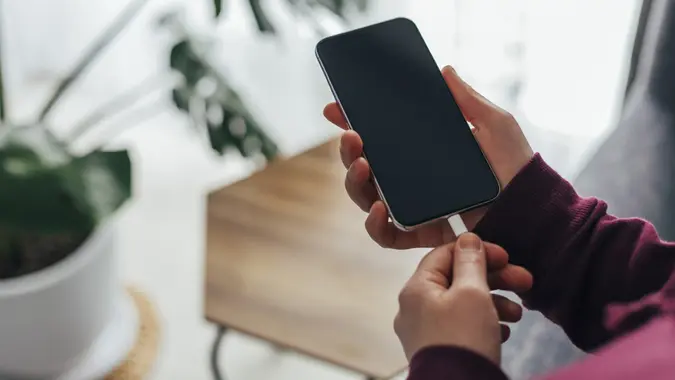8 Steps To Take First If You Want To Start Living a Frugal Lifestyle

Commitment to Our Readers
GOBankingRates' editorial team is committed to bringing you unbiased reviews and information. We use data-driven methodologies to evaluate financial products and services - our reviews and ratings are not influenced by advertisers. You can read more about our editorial guidelines and our products and services review methodology.

20 Years
Helping You Live Richer

Reviewed
by Experts

Trusted by
Millions of Readers
Living a frugal lifestyle doesn’t have to be as daunting as you imagine. It’s not about eating ramen noodles for every meal or pinching pennies — rather, it’s a strategic mindset where you are more mindful of your spending.
Sometimes it just comes down to getting started.
“Transitioning to a frugal lifestyle begins with a conscious shift in mindset — it’s about prioritizing long-term well-being over short-term gratification,” Dennis Shirshikov, head of growth at GoSummer and professor of finance at City University of New York.
Below are some steps to take first if you want to start living more frugally.
Audit Your Expenses
One of the first steps, according to Shirshikov, is to conduct a comprehensive audit of your expenses.
“By meticulously tracking your spending over a month or two, you can identify habitual purchases that add little value to your life,” he said.
Embrace Minimalism
Embracing minimalism can also be a powerful strategy, said Shirshikov.
Implementing the “one-in, one-out” rule for possessions encourages you to think critically about new purchases.
“For every new item you bring into your home, commit to removing one,” he explained. “This not only reduces clutter but also curbs impulsive buying habits.”
Leverage Technology
Leveraging technology is another non-traditional approach to frugality, experts say.
“There are numerous apps that help you find the best deals, earn cashback or even participate in community sharing programs,” Shirshikov noted.
Try Out a “No Spend” Challenge
Implementing “no-spend” challenges can make frugality a game rather than a sacrifice.
“Dedicating certain days or weeks to spend only on necessities forces creativity and highlights how much we often spend out of convenience rather than need,” said Shirshikov.
“I once participated in a month-long challenge where I avoided dining out. Not only did I save money, but I also rediscovered the joy of cooking at home.”
Adam Garcia, certified financial planner and founder of The Stock Dork, equally advocated for implementing a “no-spend” theme day.
“Set one day a week as a designated ‘No Spend’ day where you don’t spend a single dollar, including online shopping,” he said.
Garcia added that this practice goes beyond just saving; it builds a habit of intentionality.
“With time, these days become a refreshing reset that encourages creative alternatives to spending,” he said.
Consider Alternative Lifestyle Adjustments
Shirshikov explained this can involve growing your own food or engaging in barter systems.
“Starting a small garden can reduce grocery bills and provide a rewarding hobby,” he said. “In one community project I was involved with, neighbors exchanged homegrown produce and homemade goods, fostering both frugality and social connections.”
Embrace the Library as Your Learning Hub
According to Garcia, many people underestimate the value of libraries beyond books.
“Today’s libraries offer free access to workshops, online courses and even tools for borrowing,” Garcia said. “From financial literacy classes to tech gadgets, libraries are an untapped frugal resource that can replace paid subscriptions and courses.”
Practice Frugal Gifting
“Gifts do not have to explode the budget,” said Garcia.
Simple and inexpensive gift items such as a letter, a framed photograph or baked products can serve their purpose.
“Frugality gifting targets more aspects, giving more importance to the intent of the presents maligning the budget — something which is perfect for everyone to have,” he noted.
Utilize a “Cost-Per-Use” Tracker
Garcia suggested tracking the cost-per-use for items you buy. This method, he explained, reveals the true value of each item in your life, helping you prioritize purchases that will last and serve you regularly.
“It’s a game changer in helping you avoid impulse buys and choose quality over quantity,” he explained.
“These lesser-known strategies make living frugally more engaging, sustainable and rooted in value-driven decisions rather than simple cost-cutting.”
More From GOBankingRates
- Nearly 1 in 3 Americans Hit by a Costly Holiday Scam, Norton Survey Shows -- How To Avoid This
- Here's What the Average Social Security Payment Will Be in Winter 2025
- How Middle-Class Earners Are Quietly Becoming Millionaires -- and How You Can, Too
- The Easiest Way to Score $250 for Things You Already Do
 Written by
Written by  Edited by
Edited by 
























